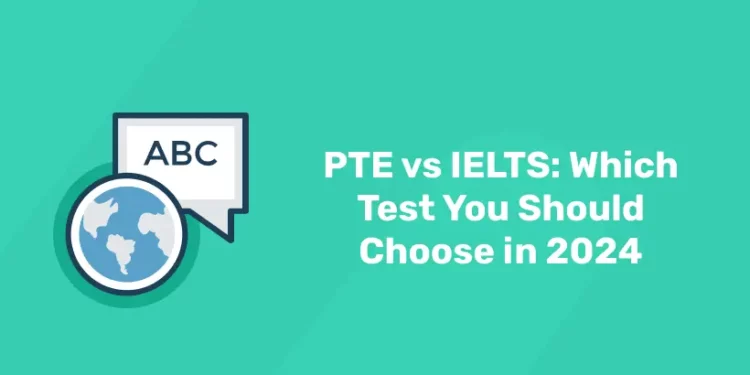Table of Contents
You must take the English language proficiency exam if you wish to pursue degree programmes overseas. You have probably encountered the PTE and IELTS tests among the many English language assessments that are available. The British Council, IDP, and Cambridge Assessment English are the owners and administrators of the International English Language Testing System (IELTS). On the other hand, ETS administers the Pearson Test of English (PTE). Although the candidates’ English language proficiency is assessed on both tests, there are some significant distinctions.
Students frequently find it difficult to choose between the PTE and the IELTS, and several thoughts cross their minds, such as which test to take. IELTS vs PTE: which is simpler? What distinguishes the PTE from the IELTS? We provide answers to all of your queries in this blog by contrasting key elements of the PTE and IELTS, such as validity, scoring structure, and exam format, to assist you in selecting the best exam.
Ready to take your German language skills to the next level? Get Free Demo Classes Here!
PTE vs IELTS: Introduction
The purpose of the PTE and IELTS exams is to gauge a test-taker’s overall English language proficiency. IELTS and PTE differ primarily in that IELTS offers a computer-delivered exam alternative in addition to paper-based testing, whereas PTE solely offers computer-based testing that is scored by a machine. Additionally, applicants converse with the examiner face-to-face in the IELTS speaking task while speaking to a computer on the PTE. The important variations between the PTE and IELTS are shown in the table below.
Understanding PTE
A computer-based assessment of language proficiency, the Pearson Test of English (PTE) is widely known. It evaluates a candidate’s comprehension, interaction, and communication skills in English in both academic and professional settings. Speaking, Listening, Reading, and Writing are the four main areas in which the test measures a person’s fluency in the English language. Pearson is the organisation that administers the tests.
Understanding IELTS
The British Council, IDP: IELTS Australia, and Cambridge Assessment English work together to administer the International English Language Testing System, or IELTS. There are two main IELTS versions: IELTS Academic and IELTS General Training, in contrast to PTE. The IELTS General Training version is frequently used for immigration purposes or to demonstrate English language proficiency in work-related contexts. Candidates seeking admission to colleges in English-speaking nations are required to take the IELTS Academic exam. both computer-based and paper-based forms are available.
PTE vs IELTS
1: Most university students ........................ on campus in their first year.
| Factors | PTE | IELTS |
| Conducted by | Pearson PLC Group | IDP Education Ltd. |
| Test Types & Format | PTE Academic | IELTS Indicator, IELTS Academic, and IELTS General Training |
| Test Duration | 3 hours | 2 hours and 45 minutes |
| Scoring Pattern | 10 – 90 points | 0 – 9 band score |
| Test Fee | INR 15,900 (USD $194) | INR 16,250 (USD $198) |
| Mean of accepted scores | 50 | 6.3 |
| Result | 48 hours after the test | 13 days after the test |
| Global Acceptance | Accepted in more than 140 countries, including the USA, Canada, Australia, New Zealand, and the UK, with over 11,500 organisations. | Accepted by more than 3,000 universities, including as INSEAD and Harvard Business School. |
Key Differences Between PTE and IELTS
IELTS offers a computer or paper option, which is, in essence, the primary distinction between it and the PTE. The PTE exam is entirely computer-based, and a machine marks the answers. Speaking on the IELTS requires you to converse face-to-face with an examiner, but speaking on the PTE requires you to speak to a computer.
The Speaking test is another significant distinction. You take the speaking portion of the IELTS exam in person with a real person. You must talk into a microphone while taking the PTE-A exam, and everyone around you must do the same.
1. PTE vs IELTS: Test Type & Format
Your English language proficiency will be evaluated in four sections of the IELTS exam: speaking, writing, listening, and reading. There are two versions of IELTS: Academic and General Training. IELTS tests take two hours and forty-five minutes to complete.
On the other hand, the PTE will use multiple integrated tasks, such Speaking-Listening-Writing, Listening-Writing, Reading-Writing, or Writing-Reading, to evaluate your English language skills. PTE and PTE General are the two forms of PTE that are offered. The PTE exam lasts for two hours and fifteen minutes.
View the table below for a breakdown of the differences in the format of the PTE and IELTS exams.
| PTE Test | IELTS | |
| Listening | This phase comprises an exam that lasts between 45 and 57 minutes, answering a series of questions based on excerpts from audio and video. | Candidates have thirty minutes to respond to forty questions after being shown four recordings. |
| Reading | Students must finish target exercises in 32 to 40 minutes, such as multiple-choice questions (MCQs), filling in the blanks, and text paragraph sequencing. | In this segment, applicants will receive three lengthy messages and have thirty minutes to respond to forty questions. |
| Speaking | In PTE, these two portions are combined and completed in 77–93 minutes. Examinees must complete a variety of tasks, including composing essays, summarising essays, describing visuals, and reading aloud. | The three components of speaking are the individual long-turn test, the discussion, and the introduction and interview. It lasts for fifteen minutes. |
| Writing | Within sixty minutes, two writing assignments must be finished. Students are required to describe a provided chart, table diagram, or graph in activity 1. |
2. PTE vs IELTS: Scoring Pattern
The IELTS score is determined using a 0–9 band score scale. The highest possible score that students can receive is nine. Most institutions, including universities, the government, and corporate organisations, have a minimum score requirement of 6.5 to 7.5.
Furthermore, the PTE exam scores are determined using the Global Scale of English (GSE), which ranges from 10 to 90 points. A candidate may receive up to 90 points. Most institutions require applicants to have between 65 and 73 points as a minimum in order to get admitted. IELTS band scores and PTE GSE scores are contrasted in the chart below.
| IELTS | 5 | 5.5 | 6 | 6.5 | 7 | 7.5 | 8 | 8.5 |
| PTE-A | 40.8 | 45.4 | 51.6 | 58.5 | 66.3 | 74.6 | 82.3 | 88.1 |
3. PTE vs IELTS: Test Fee
For both PTE and IELTS, the registration cost varies depending on the region. The PTE and IELTS tests are available in Australia for AUD$ 410 (INR 33592). PTE testing costs INR 15,900, whereas IELTS testing costs INR 16,250 in India. There will be an additional cost if you need to reschedule or cancel the exam.
4. PTE vs IELTS: Test Results and Validity
After 13 days, the IELTS test results will be available online for 28 days following the declaration date. IELTS scores are good for two years, regardless of whether you had general or academic training. You may take the test as often as you like, but you must wait at least a few months between sessions in order to adequately prepare and do well.
The PTE process is computerised, thus the findings will be made public in five business days. You will typically receive the results in two days. The validity of the PTE results is two years. After the two years, the PTE score will no longer be accessible on the PTE official website. If it’s for immigration to Australia, both the PTE and IELTS are acceptable.
Ready to take your German language skills to the next level? Get Free Demo Classes Here!
5. IELTS vs PTE: Assessment Criteria
The candidate’s performance on the IELTS exam is evaluated. Band scores start at 0 and go up to 9. Every band score corresponded to a certain proficiency level; for instance, users with a band 9 are considered experts, while those with a band 7 are considered good users. The PTE assesses a candidate’s communication abilities as well as six enabling skills: spelling, grammar, vocabulary, oral fluency, pronunciation, and written discourse.
6. PTE vs IELTS: Frequency of the Test
The availability of IELTS General Training examinations is limited to 24 days per year, but the IELTS Academic test is scheduled over 48 days. There are IELTS test locations in 140 nations worldwide. PTE exams are administered all year long in fifty different countries. Additionally, it is dependent upon the exam centres selected by the applicants being available.
7. PTE vs IELTS: Global Acceptance
Because it was established earlier in 1989, IELTS has a higher greeter acceptance rate than PTE. In more than 140 countries, more than 11,500 organisations recognise IELTS results. Since its 2009 introduction, PTE has grown in popularity. More than 3,000 universities, including Yale, INSEAD, Oxford University, and Harvard Business School, recognise PTE Academic scores. PTE is becoming increasingly and more accepted in Ireland, Canada, New Zealand, and Australia.
8. PTE vs IELTS: Difficulty Level of the Test
There are unique obstacles and problems with both the PTE and the IELTS that must be overcome in different ways. IELTS can be taken on a computer or using pen and paper. However, the PTE requires you to take the test while seated in front of a computer. In the PTE exam, there are twenty shorter tasks, however in the IELTS, there are longer tasks. To perform well in both tests, however, one must possess a thorough understanding of the framework as well as a solid foundation in English language skills.
PTE vs IELTS: Which Test You Should Choose?
It is dependent upon the test taker’s disposition, level of English language ability, and other abilities. A candidate might perform well on the IELTS speaking test if they feel at ease speaking in front of an examiner. If that’s not the case, PTE is a better option because the candidate has to talk into a microphone, and the audio is recorded by the computer. It is important to keep in mind, nevertheless, that a simple cold or sore throat may negatively impact your speaking potential PTE score.
Applicants may sit for the IELTS exam if they regularly write things down in a pen. Their ability to match pace and time will help them receive a high band score. However, if you are more adept at typing on a computer and find writing by hand uncomfortable, you can take the PTE exam. It’s preferable to take practice exams for both the PTE and the IELTS to see which one works best for you. Better English language proficiency and regular practice, however, are essential for improved performance.
Entri App- Best German language Course in Kerala
Begin your journey of learning German in Kerala with Entri app. Get expert training in your local language, starting from A1 level, and receive Goethe exam assistance for a comprehensive learning experience. Everyone can benefit from Entri’s German language training. It provides students of different ability levels with a well-structured curriculum. German comprehension is ensured by the course’s interactive exercises and professional coaching. Entri’s course is made to support you in making smooth progress, regardless of your level of experience. According to your needs, kindly click on the links provided below.
Ready to take your German language skills to the next level? Get Free Demo Classes Here!
FAQs
Q. Which is easy to crack PTE or IELTS?
Ans: It is impossible to classify either exam as easy or challenging. Nonetheless, some may find one more palatable than the other when considering the variations in pattern and structure. Furthermore, the PTE has an adaptable format, while the IELTS has a set amount of questions.
Q. Which country prefer PTE?
Ans: Australia, Canada, New Zealand, and the United Kingdom have all recognised PTE results for academic admissions and immigration purposes.
Q. Which is better IELTS or PTE for PR?
Ans: IELTS is widely accepted and has a global reach. PTE is a much more recent test than IELTS, and it is not as well-known throughout the world. IELTS is the best option if you want your application to be seen by as many people as possible.
Q. What is the most difficult part in PTE?
Ans: Among the three categories, the PTE Reading section is regarded as the most challenging. A lot of test-takers fail to score well on reading comprehension questions. Collocations are the main topic of most Reading & Writing; Fill in the Blanks of the Reading section questions.
| Related Links | |
| German Language A1 Course Online Coaching | German Language A2 Course |
| German Language B1 Course online Coaching | German Language B2 Course Online Coaching |









